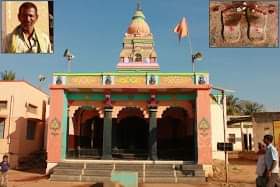
What is PARYUSHAN?
It is the holiest 8-day festival in the annual Jain calendar followed by Shwetambar Jains. Similarly, Digambars follow Das Lakshana, a 10-day spiritual festival that starts when Paryushan ends, on the Samvatsari day.
#jainism #jain #paryushan #festival
It is the holiest 8-day festival in the annual Jain calendar followed by Shwetambar Jains. Similarly, Digambars follow Das Lakshana, a 10-day spiritual festival that starts when Paryushan ends, on the Samvatsari day.
#jainism #jain #paryushan #festival

This festival is important for Jains since it only comes once in a year. #Jain festivals are characterized by renunciation, austerities, study of the scriptures, repetition of holy hymns, meditation & expressing devotion for the Paramatma. 







Not only underground vegetables but consuming of fresh vegetables & fruits is also prohibited during Paryushan. Everyday some or the other Tap is followed. In any tap, chauvihar is a must ie, No food or water after sunset until Navkarsi (48 minutes after sunrise) next day. 







History of Pajjusan & Kalpasutra:
The original word for Paryushan is 'Pajjusan'. References are found in the Jain scriptures-Kalpa Sutra, Samvaayang Sutra, Nishith Sutra & Nishith Bhashya Churni. Preachings of Lord Mahavir were orally compiled into Agams by his disciples
#Jain
The original word for Paryushan is 'Pajjusan'. References are found in the Jain scriptures-Kalpa Sutra, Samvaayang Sutra, Nishith Sutra & Nishith Bhashya Churni. Preachings of Lord Mahavir were orally compiled into Agams by his disciples
#Jain

Agams are divided into 12 & are called the Anga Agam - 11 Angas & 14 Pūrvas (12th Anga Drstivada is lost). However a detailed table of contents of Drstivada has survived in the 4th Anga Samavāyānga & Nandīsūtra. Some portions hv survived in Satkhandāgama & Kasāyaprabhrta as well. 

From the 9th Purva of Drstivad is Pratyakhyan Pravd Purva, which is about Pachchhakhän - giving up, restraint, vows, detachment etc, Acharya Bhadrabahu prepared a chhedsutra (for monks & nuns only) named DASHASHRUTSKANDHA that has 10 chapters. Chapter no.8 is the KALPASUTRA 

Originally called 'PAJJUSAVANA KAPPA, it focuses on the conduct of Monks during Monsoon. It commonly came to be known as KALPASUTRA or BARSA SUTRA as there are 1215 shlokas in this Moolsutra. It is recited during Pajjusan touching every aspect of the life of Chaturvidhi Sangh. 

Pajjusana comes in the 3rd section of the Kalpasūtra called 'Sāmācārī' (saamaachari/Right Monastic Conduct) expressed as "vāsā-vāsaṃ pajjosavei" ie, to perform the Pajjusana rites during the peak of Chaturmas, which in those days was considered to be a month+20 days. 

Farmers etc would often be compelled to refrain from their agricultural work during Rainy season. It was challenging to travel on roads, the added moisture caused an increase in the no. of insects & bugs in the environment, making it extremely difficult to travel w/o harming them 

Learning of the sacred Agams was carried out only amongst the Sadhus initially. Then, in Vikram Samvat 523, King Dhruvsen of Anandpur, a capital of Gujarat lost his son & went into grief. He requested Acharya Kalaksuri to relieve him from grief. The days of Paryushana were close. 

For the 1st time in public & chaturvidhi sangh, there was an oration about the importance & power of Pajjusana & the Shravan Paathan of Kalpasutra. His grief vanished after listening. Next year, he requested again for the discourse & since then this parampara has continued. 

Kalpasutra has 291 Sutras (1215 shlokas) in total and is divided into 3 parts -
➡️ 200 sutras on the life of 24 Tirthankars
➡️ 23 Sutras on the succession of pupils of Tirthankar Mahavir
➡️ 68 sutras on the Aachar Jivan (Samachari) of the monks during monsoons
#agam #Jainism
➡️ 200 sutras on the life of 24 Tirthankars
➡️ 23 Sutras on the succession of pupils of Tirthankar Mahavir
➡️ 68 sutras on the Aachar Jivan (Samachari) of the monks during monsoons
#agam #Jainism

Monks should find a suitable place to stay before Chaturmas starts & stop Vihar. In case they donot find, a grace period of 50 days was given to keep looking for it.However if they don't find, on the 50th day they must do Pratikraman under a tree. This day was named as SAMVATSARI 

Acharyas added days prior or post to this day & it became a festival. After performing Pratikraman, Jains seek forgiveness from all the creatures of the world whom they may have harmed knowingly or unknowingly by uttering the phrase - 'Micchami Dukkadam' or 'Khammat Khamana'. 

• • •
Missing some Tweet in this thread? You can try to
force a refresh





















